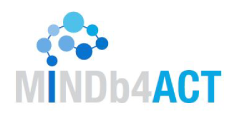 https://www.synyo.com/wp-content/uploads/SYNYO-NEWS-featured-image-NEW01009002EN.png
400
459
leo
https://www.synyo.com/wp-content/uploads/2017/09/synyo-logo.png
leo2025-08-01 13:48:032025-10-20 13:50:29METEOR Programme development and work package and outreach updates
https://www.synyo.com/wp-content/uploads/SYNYO-NEWS-featured-image-NEW01009002EN.png
400
459
leo
https://www.synyo.com/wp-content/uploads/2017/09/synyo-logo.png
leo2025-08-01 13:48:032025-10-20 13:50:29METEOR Programme development and work package and outreach updatesMINDb4ACT

MINDb4ACT: Common policy implications and recommendations for countering violent extremism
The MINDb4ACT project conducted a comprehensive analysis of policies and strategies, while the partners have implemented a set of living labs in different partner countries. Based on the outcomes of the research and analysis, the partners propose policy recommendations both for the national as well as for the European level. These common recommendations are focussing on five core themes, which are considered to be relevant for improving prevention and countering of violent extremism.
Based on the research and policy analysis conducted in the project, the article highlights a number of considerations and perspectives for the prevention and countering of violent extremism. The following common recommendations were derived from the project.
Inclusivity
Both implementing agents and stakeholders must understand the logic of an inclusive process. For the former, a participative evaluation will facilitate data collection and ensure that the actors responsible for maintaining the intervention take the results into consideration. For the latter, the appropriation of the process will ensure its usefulness; only in this way will it respond to their interests and needs and reflect viable solutions pointing to achievable goals while optimising available resources. Not involving the stakeholders in the evaluation work from the start of the project, or losing their help along the way, can prevent the evaluation from informing decision making and thus truly contributing to an evidence-based policy.
Pragmatism
During the evaluation, it is critical to manage expectations, both in terms of the process’ ambitions and in relation to the established objectives and expected results. It will allow a rigorous and reliable working structure in which efforts are not limited to testing results that can be externally questioned. Realism should govern the design of the evaluation criteria as well as the implementation of the work, thus enabling the collection of detailed data that will allow for a better understanding of how a project helps bring about a specific change. Finally, realism must also prevail in the analysis, since the recommendations drawn from the evaluation must be actionable enough to bring true improvements to prevention and countering violent extremism.
Transparency and ethics
Choosing an internal evaluation model is a pragmatic decision in short-term, low-budget projects. It allows for optimizing resources while strengthening the implementing agents’ competencies. However, its usefulness can be affected by the caution with which its results are usually interpreted. Ensuring a transparent process with stakeholders and political decision makers will make it possible to counter those doubts. To that end, it is important for the evaluators to keep up a regular and fluid conversation with the rest of the actors who are involved or interested in the project. They should share the methodological design of the evaluation and the data collection tools in order to allow for their validation and report on the progress of the process implementation.
Evaluators should likewise offer the raw data collected as well as any other element used in the analysis (relationship of analysed documents, interviewed individuals, etc) so that they can be studied independently. Transparency must also prevail in the relationship with the evaluation participants, in compliance with ethical standards. The subjects evaluated must be informed about the project initiatives and the consequences of their involvement in the evaluation. Being transparent with them will also foster a greater degree of involvement in the process. Finally, transparency with the rest of the P/CVE ecosystem should take shape in the publication and dissemination of the evaluation results, which will allow for an exchange of best practices and empirical findings, thus contributing to expanding the available literature on the evaluation of P/CVE interventions.
Utility and finality
The objectives of the evaluation must be clear both for the evaluators and for the stakeholders, such that they can guide the work to be done. It must be considered that an evaluation can serve various purposes: while the practitioners will have a stake in knowing the results of an intervention, policy makers can use the results to make decisions about the distribution of resources or investment increases. Besides, the evaluation does not only have the single aim of determining whether a project works or not; it also sheds light on which elements worked and which did not, for which beneficiaries, in what way, under what circumstances, to what degree, and why.
Gender perspective
Incorporating a gender perspective in the evaluation of P/CVE projects meets the need of understanding in a comprehensive way the effects of an intervention on its beneficiaries and, ultimately, on the institutional and organisational level. Gender-segmented data collection must be considered in the evaluation design, executed during the implementation and reflected in the analysis. Ideally, it must include recommendations to usher in changes that improve the project’s impacts in this dimension.
Media: Position 1 (optional, additional information on the position in brackets)
Conclusions
In European political and academic areas, there is a widespread perception that there is currently an insufficient empirical knowledge base on the effectiveness and impact of P/CVE efforts. If this is evident on the level of national and regional policies, it is even more so for small-scale interventions led by actors who are just starting out in this field. The project takes the pulse of the challenges and limitations that these actors face, with the goal of encouraging them to develop a culture of evaluation. Some of these deficiencies emerge in the very conceptualisation and planning of the evaluation efforts, and have to do with the lack of inclusiveness and pragmatism in the design of evaluation frameworks. Others come up in the actual implementation of the work, due to operative and analytical constraints that affect the data collection. Finally, some of those limitations crop up in the analysis of the results, and can be due to the presence of bias among the evaluators and evaluated persons, but also to a lack of transparency and realism.
Links
https://cordis.europa.eu/project/id/740543
Keywords
Radicalisation, policy recommendations, whitepaper, prevention, extremism




